How has the pandemic affected international expansion in video games?
A new survey details the rise of cloud technologies amongst developers, concerns around DDoS attacks and global expansion plans
About 80% of game companies plan to expand internationally, but they fear technological difficulties in new markets, including DDoS attacks, according to global research by G-Core Labs & Censuswide.
In June, G-Core Labs, an international provider of cloud and edge solutions, teamed up with the Censuswide British research agency to conduct the research project: 'World video games industry 2020-2023: Trends, Technologies, Challenges'. Representatives of 50 large, medium, and small video game developers from the USA, Great Britain, EU and CIS countries took part in a survey. They shared their experiences working during the peak of quarantine measures in spring.
In addition, they gave their opinions on what the market would look like within the next three years. The participants mentioned trends and challenges, current and future technology, monetization models, game formats in development, expansion plans to new regions, and issues related to such expansion.

How Has the Pandemic Affected Plans for International Expansion?
The coronavirus pandemic and the associated self-isolation policy introduced during spring in many countries around the world have had a significant impact on the video game market. Limited in the ability to enjoy the usual forms of communication and leisure, people of almost all ages began to spend more time online than before, whether it was to work, shop, connect with friends, or, of course, play games.
As a result, 84% of the surveyed game companies said that they experienced increased loads on their IT infrastructure in March to June of this year during the peak of quarantine measures. At the same time, 69% of respondents noted that the load increased from 51% to 100%, while another 17% of companies recorded an increase in load from 101% to 200%.
According to many respondents, the trend of further migration of leisure and entertainment online will continue, and the pandemic has acted as a catalyst for this process. In connection with this, 78% of respondents said they plan to enter new markets (countries or regions).

The respondents identified Western Europe (46%), Central Asia (46%), and India (38%) as the main areas of international expansion. The regions of North America (28%) and Southeast Asia, including China, (28%) are also in demand.
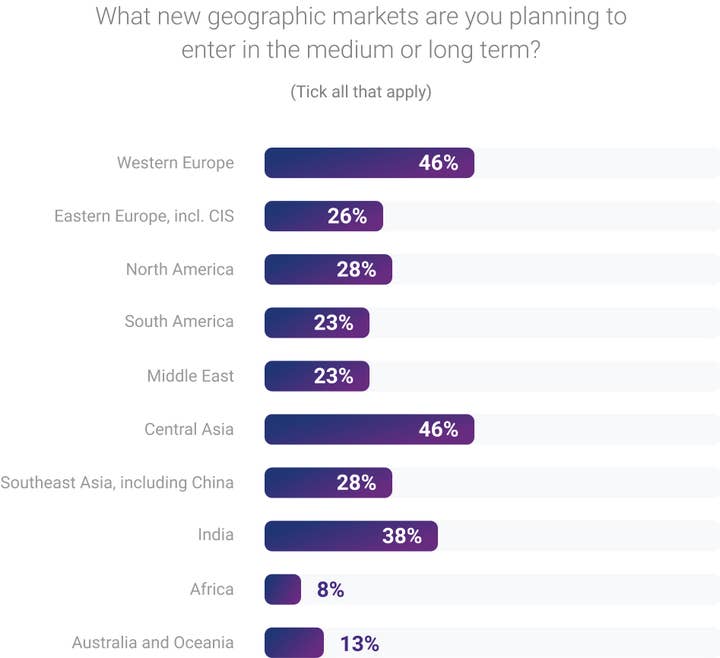
New Market Challenges
At the same time, new markets mean new challenges. Among the main issues that had to be solved while developing business in foreign regions, representatives of game companies noted the growth of DDoS attacks on IT infrastructure (46% of respondents), issues with Internet connectivity and bandwidth in the local market (38%), and lack of qualified engineers (38%).

"G-Core Labs is well acquainted with each of these issues," says Dmitry Samoshkin, VP of Products at G-Core Labs. "We started as a cloud infrastructure operator specifically for the gaming market and the media industry, so we fully understand the challenges that many of our customers from these sectors faced when they were entering new markets, including North and South America, Asia, India, the Middle East, and Australia.
"From our own experience, we can say that most of the problems mentioned in the study, including Internet connectivity, the availability of stable IP transit, reliable data centers, and, especially, the difficulties caused by DDoS attacks, are best solved centrally by choosing a high-quality cloud partner who provides reliable hosting with 24/7 support, a content delivery network, storage, and protection of the entire infrastructure from any DDoS attacks, even the most complex and voluminous ones. Over the years, G-Core Labs, in my opinion, has managed to form a pool of high-quality products and services for efficient and uninterrupted operation in any region of the world."
The most problematic markets from a technical standpoint, according to the companies surveyed, are India (38%) and Southeast Asia, including China (32%). Also, respondents experienced technical issues in North America (24%), Western Europe (22%), and the Middle East (22%). Only 4% of respondents didn't encounter any technical issues in new markets.
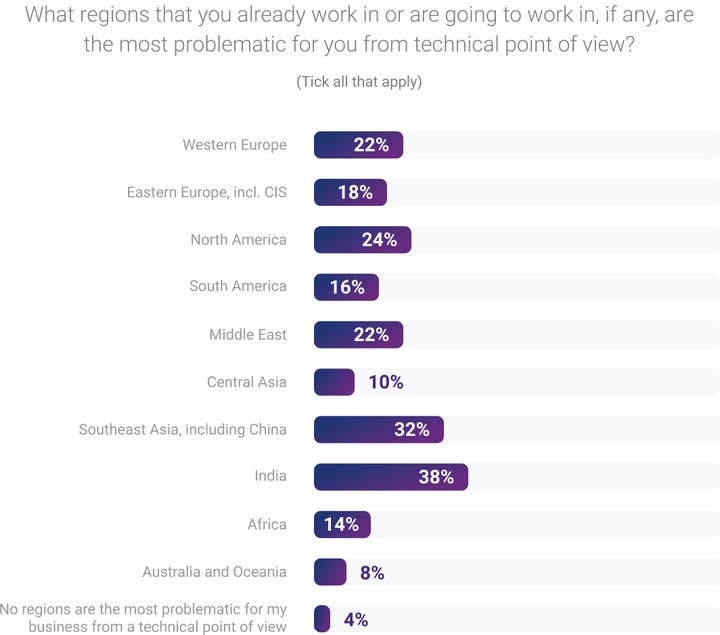
Stoppers and Growth Factors in 2020 -- 2023
Among the factors that could slow down business development in 2020 and for the next two to three years, the respondents most frequently noted cyberattacks, including DDoS attacks (66%), changing user preferences (66%), and an increasing number of competing products and companies, resulting in an oversaturated market (64%). Technical limitations of communication networks and the internet in the regions of presence were also mentioned (34%).
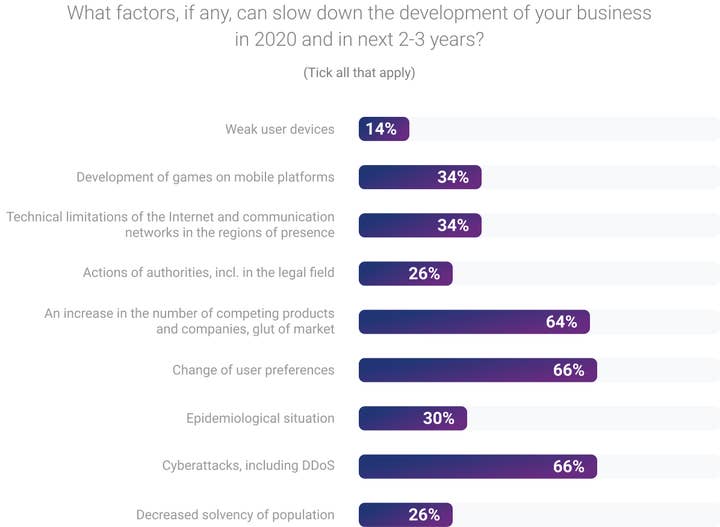
"According to the gaming industry, one of the main technical challenges that can significantly affect a business is unfair competition in the form of DDoS attacks, which are, unfortunately, very common in the field of video games," says Andre Reitenbach, CEO of G-Core Labs.
"Issues with Internet connectivity in target regions is another challenge. G-Core Labs is highly experienced at solving such issues. For example, we supported the entry of RedFox Games, a popular American game developer [Black Desert, RF Online, and Rumble Fighter], into the South American market.
"For foreign companies, Latin America is a difficult market to enter: the infrastructure is undeveloped and there is poor connectivity between providers, which is very typical for emerging markets. We faced similar problems when we were building the infrastructure for World of Tanks in CIS. That's why when RedFox Games contacted us, we already knew where to start. The RedFox Games hosting cluster was set up in an optimal location: Miami. That point is located at the junction of IX [Internet Exchange] and is as close to Latin America as possible. During the first tests, traffic did not flow directly, which increased the delay significantly, sometimes until it was completely lost. In order to set up the optimal route, we even obtained an internet service provider license, contacted all the major providers, and made agreements that ensured our traffic would go the shortest route possible."
Andre Reitenbach adds: "But that was not the end of the problems. Before RedFox Games appeared on the Latin America market, there were pirated services with the Black Desert game. And when the project was in Closed Beta, DDoS attacks began against the legal publisher. During the first two weeks, we faced numerous attacks of various types, some of which reached 300 Gbps at their peak. Thanks to the high-end equipment based on Kinetic and using local scrubbing centers, G-Core Labs successfully repelled all unfriendly actions."
The main consequences of DDoS attacks for survey participants were criticism and a decrease in user loyalty (56% of respondents), unavailability of their games for more than one hour (52%), and allocation of significant internal company resources to counter attacks (46%). Also, 26% of respondents noted direct financial losses as a consequence of DDoS attacks.
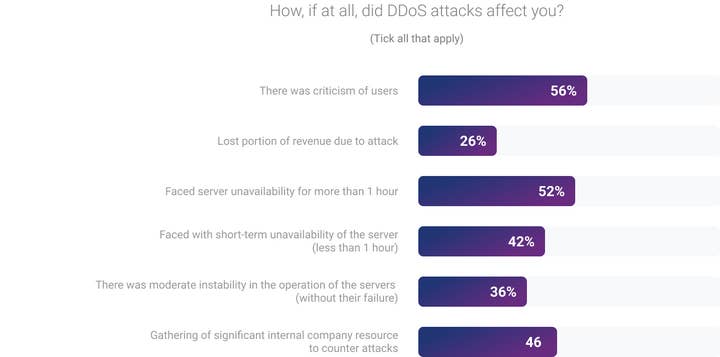
"Not all companies are ready to admit that they lose money because of cyberattacks," notes Dmitry Samoshkin. "We know though that for larger publishers with an audience of, let's say, three to five million players, each successful DDoS attack lasting less than an hour results in about €15,000 to €25,000 of lost profit."
Respondents from the video games industry named the following broad-based technologies that it plans to use (i.e. technology applicable for all entertainment genres and formats): cloud gaming, which involves using external servers for all processes while users receive only video streams to their devices, and VR/AR. 82% and 66% of respondents said they already use the aforementioned technologies or they plan to use them, respectively. Also, 40% of respondents see potential in implementing AI technology and another 30% plan to work, or are already working, with big data technologies.
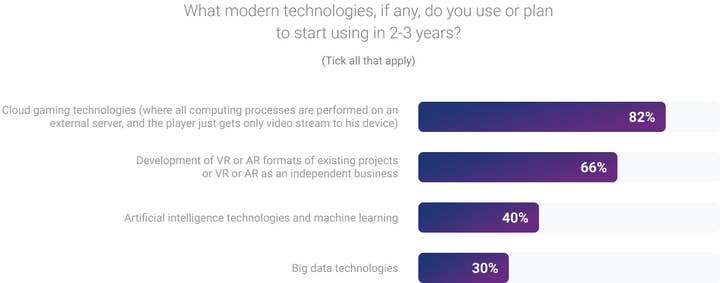
The widest implementation of VR and AR technology is expected among developers of various simulators (sports, city-building, and so on) as 82% of such companies who develop this genre expressed interest in them. Simulators also hold a leading position in implementing AI (53%). Quest publishers are most interested in, or are already working with, Big Data (48%).
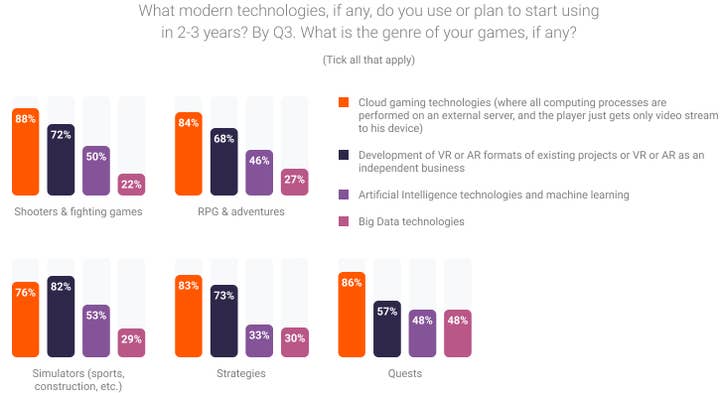
"Today, we see a growing interest from our customers in the game dev industry regarding artificial intelligence, and this is not surprising," states Reitenbach. "This technology opens up a number of opportunities for market players, including accelerating game development, designing interfaces at a new level, improving graphics, accurately moderating user content, programming character behavior, retaining players, and increasing player involvement. G-Core Labs offers a unique platform for working with applications based on AI. Through the cloud, we provide customers with a ready-made infrastructure for development with a GPU, a framework, and the necessary functionality to train and inference machine learning models. The management of all the necessary resources is carried out using an intuitive interface, and payments are made based on a pay-as-you-go model."
Another survey participant mentioned one more future trend -- cooperative (or shared) virtual reality: "This is the future of the games industry. Until now, VR was always seen as an innovation that separated gamers from one another. But for new, quality development of video games, we must work together on a shared virtual reality where players actively interact with each other, thereby receiving a previously unattainable experience."
To solve their daily tasks, including work with high loads and peak traffic, the survey participants actively use the cloud. 50% of respondents work with a private cloud and 40% with a public cloud. At the same time, almost all (90%) video game developers and publishers use, or plan to use, hybrid solutions that combine the capabilities of a private and public cloud.
63% of the survey respondents use the capabilities of public and hybrid clouds in case there are increased loads on the infrastructure or peaks in traffic. Other popular scenarios for these types of clouds are game production (61%) and development (53%).
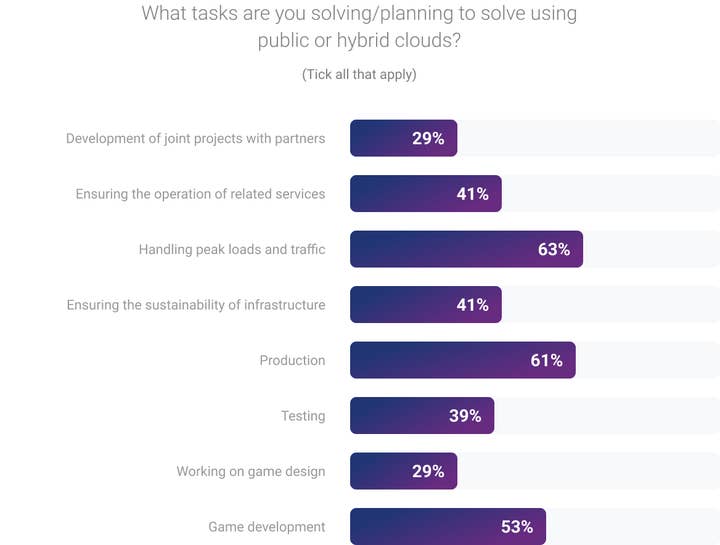
For the private cloud segment, the most common scenarios are supporting game production (64%) and working with increased infrastructure loads, traffic, and game development (48% each).
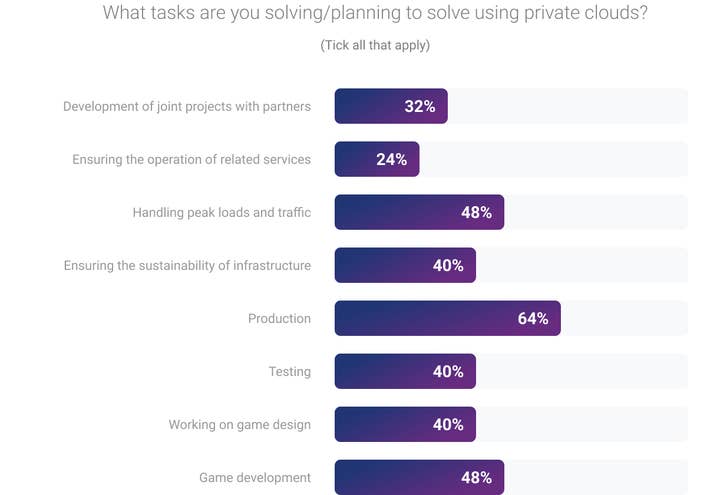
Reitenbach continues: "Today, the use of cloud infrastructure has become mainstream in the video games industry. It's worth mentioning that one of our esteemed clients -- Wargaming, a world leader in the market of multiplayer games with World of Tanks, World of Warships, and other hits -- uses both public and private clouds from G-Core Labs that are fully customized to their needs. The main tasks that Wargaming solves with the help of G-Core Labs clouds are game development and design, testing new projects, work with peak loads during high season and promotions, and ensuring the production for a number of their latest games."
Game Genres and Formats
78% of respondents said that they were developing mobile games, 70% of respondents are working on console and PC projects, while 60% of study participants were releasing browser games.
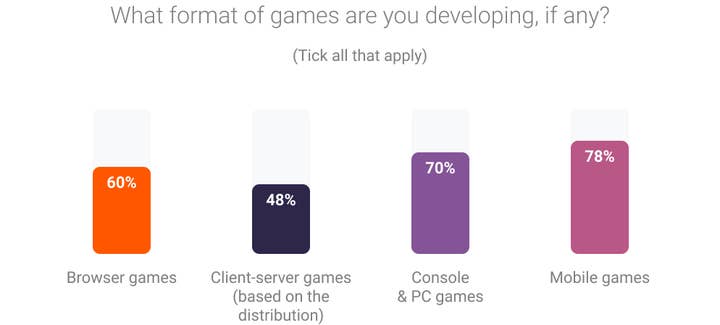
The most developed game genres among the responding companies were RPGs and adventures (74%), shooters and fighting (64%), and strategy (60%).
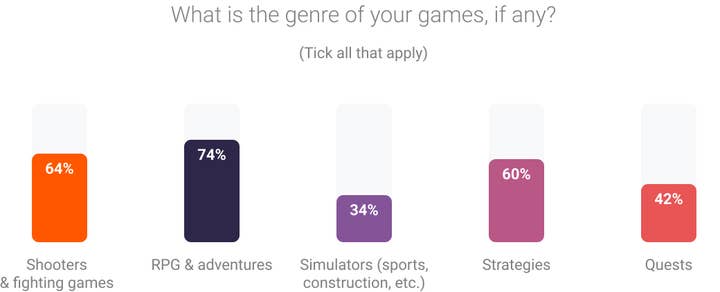
Monetization Models
The most popular monetization models used by developers and publishers in the video games industry are in-game purchases (extra characters, in-game items, extra time in game, and so on.), subscription offerings, and in-game advertising solutions. The use of these methods was reported by 74%, 60%, and 52% of all the companies surveyed, respectively. Direct sales of video games (via download stores or retail outlets) was reported by just 18% of respondents to the survey.
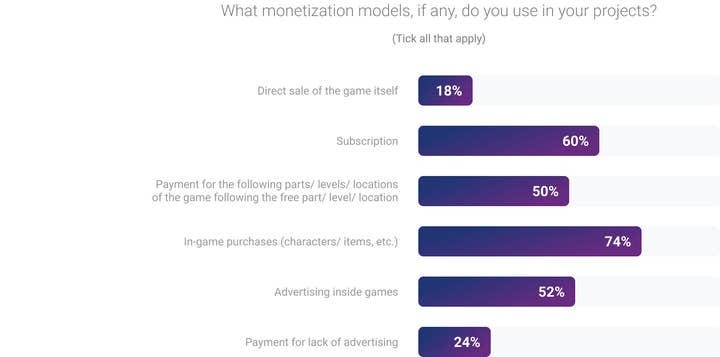
You can find the entirety of the research results here.
For more information on G-Core Labs, click here.
